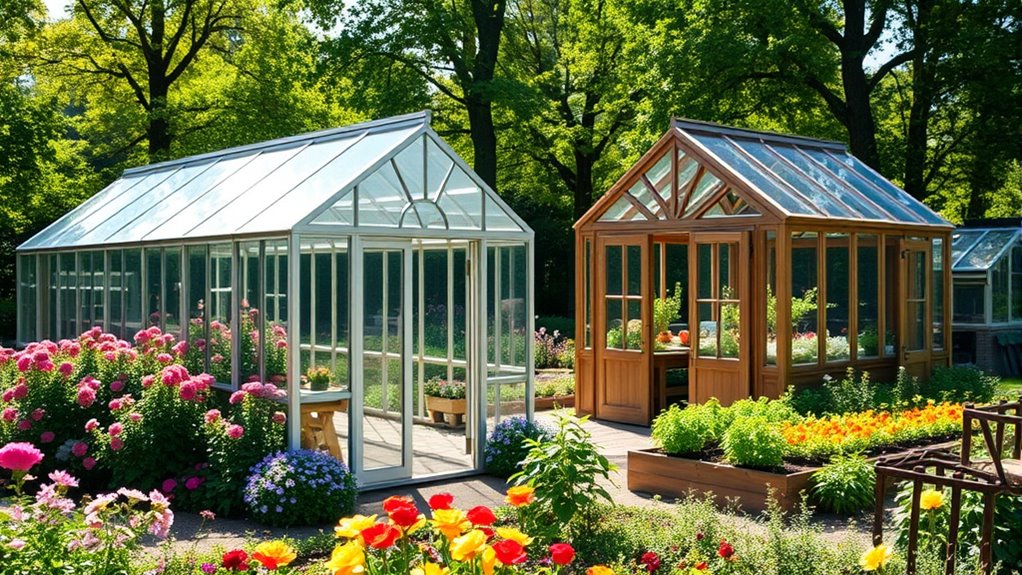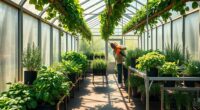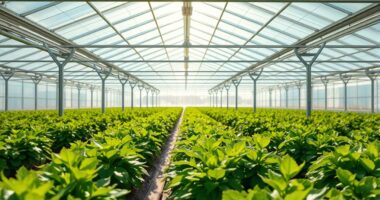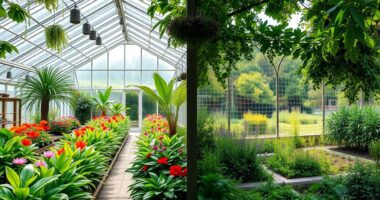To choose the right size greenhouse for your garden, first assess your available space and guarantee there’s enough sunlight. Define your gardening goals, like what plants you’ll grow and their spacing needs. Understand the different greenhouse sizes—from small to large—and consider the design that fits your style. Don’t forget to account for ventilation systems to maintain temperature. By considering these factors, you’ll make an informed decision. Keep going to uncover more details and tips!
Key Takeaways
- Assess your gardening goals to determine the types and number of plants you want to grow, which affects greenhouse size.
- Allocate 1 to 2 square feet per plant for optimal growth and plan accordingly for the total area needed.
- Consider the greenhouse height to accommodate air circulation and any climbing plants you may want to grow.
- Measure your available space, ensuring the greenhouse fits within your area while allowing for easy access and maintenance.
- Check local zoning regulations to ensure compliance with size, height, and location requirements for your greenhouse.
Assessing Available Space

When choosing the right size greenhouse, the first step is evaluating the available space. Accurately measure the area where you plan to install the greenhouse. Confirm it gets at least six hours of direct sunlight daily, as this is essential for healthy plant growth.
Consider the distance to water sources for easy irrigation and assess accessibility for maintenance tasks. Don’t forget to leave extra space around the greenhouse for pathways. Check drainage to prevent water pooling and identify any obstacles that might interfere with placement.
Make sure the ground is level and think about wind protection for structural integrity. Finally, assess nearby structures that could impact sunlight or airflow to create an ideal growing environment.
Defining Gardening Goals
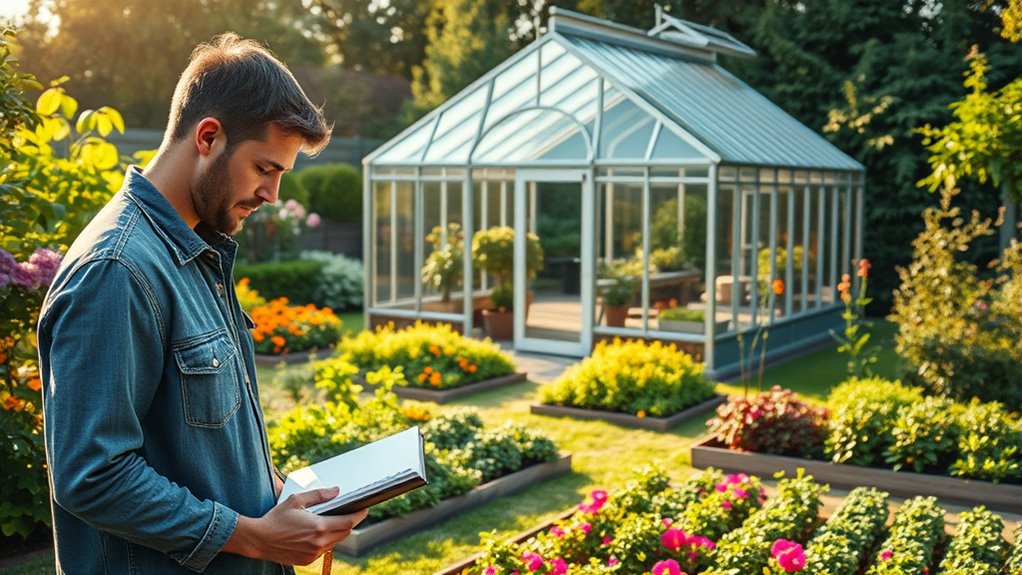
When defining your gardening goals, think about the types of plants you want to grow and their specific space requirements.
If you’re aiming for year-round gardening, consider the extra space and systems you’ll need for insulation and lighting.
Having a clear vision will help you choose the right greenhouse size to meet your needs.
Plant Selection Considerations
As you define your gardening goals, consider the types of plants you want to grow, as this will impact your greenhouse’s size and layout.
Here are three key factors to keep in mind:
- Temperature Requirements: Different plants thrive in varying temperature ranges, so choose those suited to your climate.
- Light Requirements: Assess whether your plants need full sun or partial shade, as this will influence your greenhouse orientation and design.
- Space Requirements: Larger plants, like citrus trees, need more room, so plan accordingly to avoid overcrowding.
Year-Round Gardening Needs
To successfully achieve year-round gardening, it is vital to define your specific goals and needs. Consider how often you want to garden, the variety of plants you wish to grow, and the climate challenges you might face. Evaluating these factors helps you choose the right greenhouse size.
Here’s a quick overview of key considerations:
| Factor | Importance | Notes |
|---|---|---|
| Gardening Frequency | Consistent conditions | Essential for year-round growth |
| Space Requirements | Insulation & systems | Accommodate heating and lighting |
| Energy Efficiency | Cost reduction | Look for sustainable designs |
| Plant Variety | Diverse crops | Adapt to temperature needs |
| Climate Adaptation | Weather resilience | Guarantee structural durability |
Additionally, understanding your specific gardening goals will guide you in selecting the optimal greenhouse size to meet your needs.
Evaluating Budget and Costs
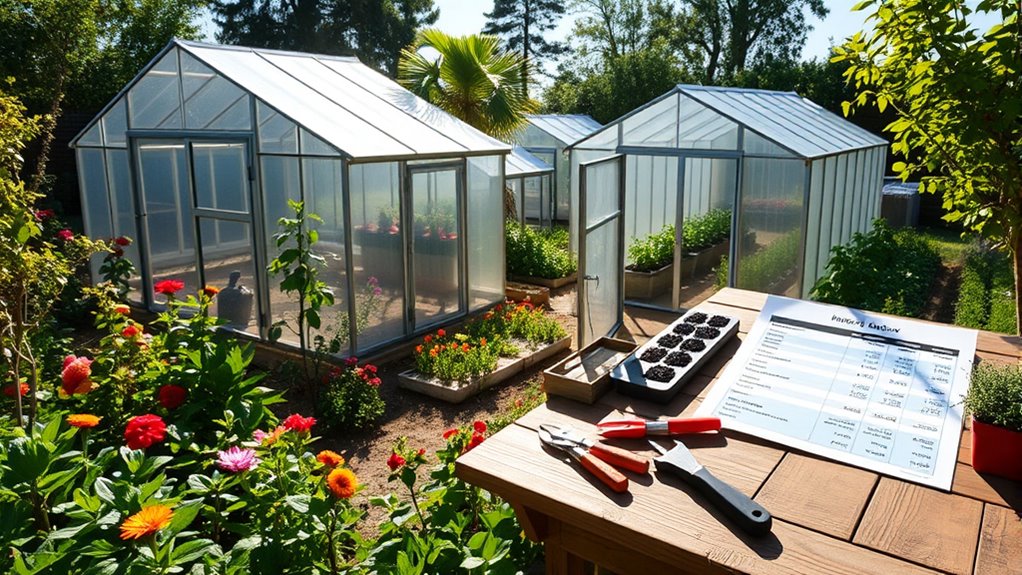
Evaluating your budget and costs is essential when choosing the right size greenhouse. Start by identifying key financial factors to guarantee you’re making a wise investment:
- Initial Costs: Assess material costs, structural complexity, and site preparation needs, as these will greatly impact your budget.
- Operational Expenses: Consider ongoing costs like energy consumption, water management, and maintenance. Efficient systems can save money in the long run.
- Long-Term Costs: Invest in durable materials and energy-efficient systems to minimize future expenses.
Understanding Greenhouse Sizes
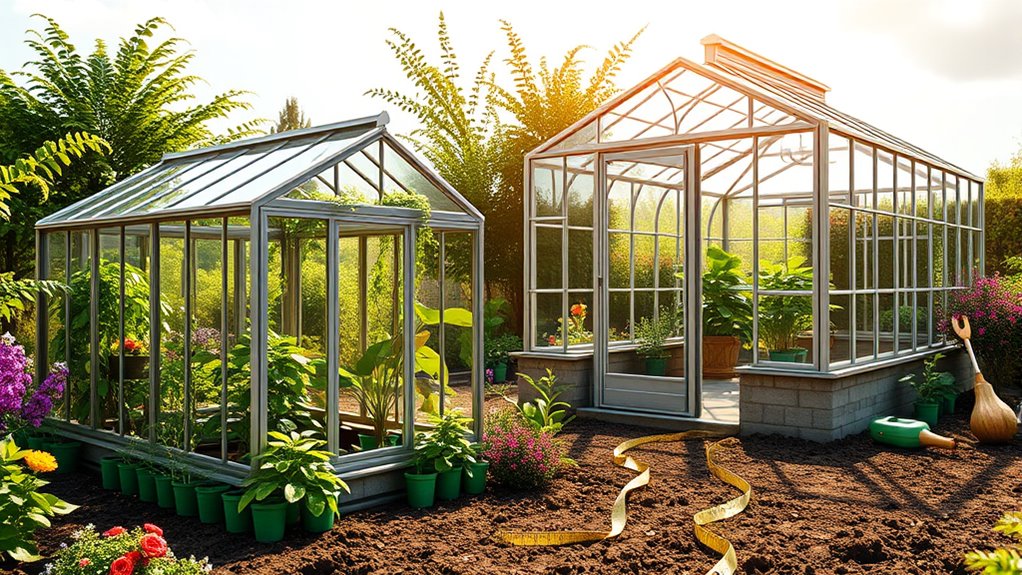
When selecting a greenhouse, understanding the various sizes available is essential for meeting your gardening needs.
Small greenhouses, typically ranging from 6×4 ft to 6×8 ft, are perfect for starting seeds or growing a few herbs.
Medium greenhouses, usually 8×10 ft to 8×12 ft, allow for a more diverse range of plants.
If you’re a serious gardener or planning for small-scale commercial growth, consider large greenhouses that are 10×12 ft or larger.
Don’t forget height; taller models (10-14 ft) provide better air circulation and space for climbing plants.
Always allocate 1 to 2 square feet per plant and measure your available area carefully to guarantee ideal sunlight and accessibility for your greenhouse.
Considering Greenhouse Design
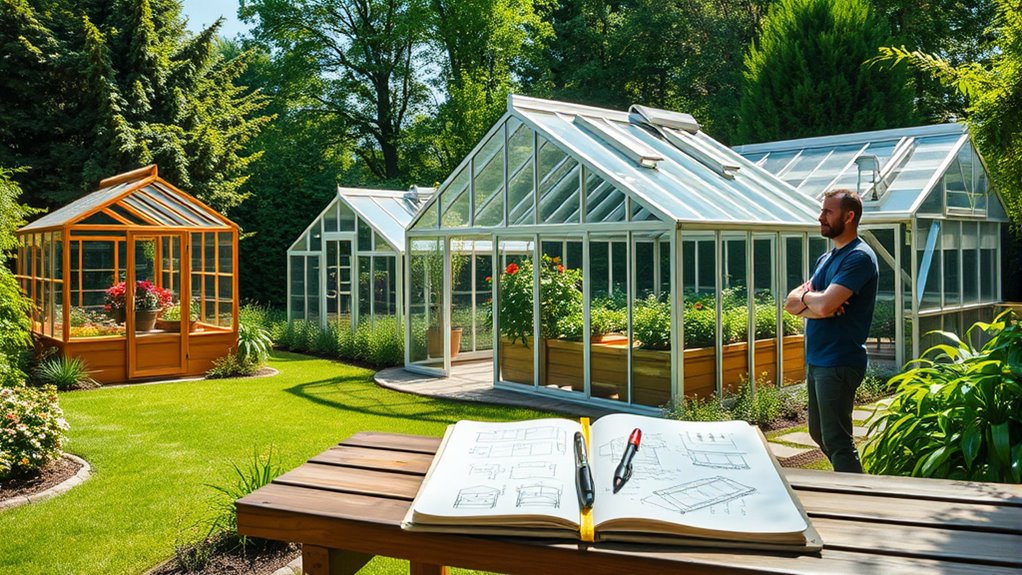
When you’re considering greenhouse design, think about the shape and structure that best suits your needs.
Choosing the right materials can enhance durability and insulation, while proper ventilation and flooring play essential roles in maintaining a healthy environment for your plants.
Each of these elements contributes to the overall functionality and efficiency of your greenhouse.
Shape and Structure
Choosing the right shape and structure for your greenhouse can greatly impact its functionality and efficiency.
Consider these options to find the best fit for your garden:
- Gothic Arch Greenhouses: Their arched roofs offer superior wind resistance and can handle heavy snow loads.
- Gabled Roof Greenhouses: These provide strength and support for equipment, thanks to their sloping trusses.
- Sawtooth Greenhouses: Designed for natural ventilation, they help regulate temperature effectively.
Think about your local climate, space availability, and intended use when selecting a design.
Each shape has unique benefits that can enhance your gardening experience, so weigh your options carefully to make the best choice for your needs.
Material Selection
Selecting the right materials for your greenhouse is essential, as it directly influences its durability, efficiency, and overall performance. Consider frame materials like wood, metal, or PVC, each with unique benefits and costs. For coverings, options like polyethylene film, glass panels, or polycarbonate sheets provide varying levels of insulation and light transmission. Additionally, understanding your specific greenhouse goals will help you make more informed material choices.
Here’s a quick comparison:
| Material Type | Key Features |
|---|---|
| Wood Frames | Aesthetic, requires rot-resistant types |
| Metal Frames | Durable, rust-resistant (aluminum) |
| PVC Frames | Affordable, lightweight, less durable |
| Glass Panels | Excellent light, heavy, costly |
| Polycarbonate Sheets | Strong, good insulation |
Choose wisely based on your climate, budget, and greenhouse goals!
Ventilation and Flooring
After you’ve chosen the right materials for your greenhouse, ventilation and flooring become key factors in your design.
Effective ventilation helps manage humidity and temperature, reducing plant disease risks. You can consider these options:
- Natural Ventilation: Perfect for small greenhouses in mild climates, using wind and thermal buoyancy for airflow.
- Mechanical Ventilation: Best for larger greenhouses in hotter climates, using fans to circulate air and exhaust heat.
- Air Circulation: Incorporate gentle circulation fans to avoid hot spots and stagnant air.
For flooring, guarantee proper drainage and leave space for maintenance paths.
A well-planned ventilation system and flooring layout will optimize your greenhouse’s functionality, allowing for a thriving garden.
Planning for Future Expansion
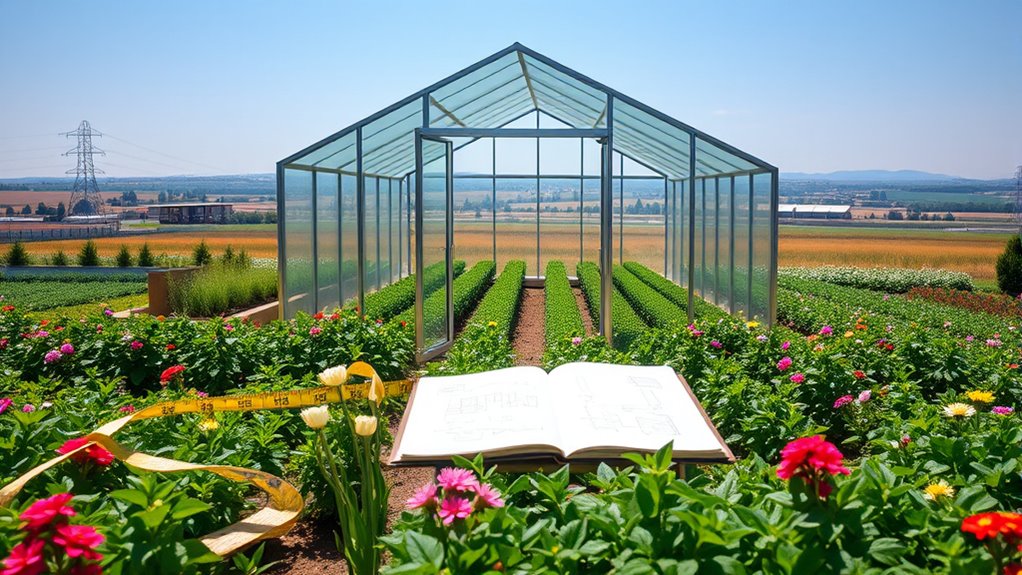
As you plan your greenhouse, it’s essential to think ahead about future expansion. Start by evaluating your current needs based on the types of plants you want to grow.
Consider the potential growth in plant variety or quantity, and review any space constraints, such as zoning restrictions or neighboring properties.
Don’t forget to budget for future upgrades, including heating, cooling, or irrigation systems. Engaging with greenhouse manufacturers or construction experts can help you create feasible and efficient expansion plans.
This foresight not only prepares you for growth but also guarantees that your greenhouse adapts to changing gardening goals while complying with local regulations.
Planning now will save you time and money later!
Choosing the Right Materials

When you’re building a greenhouse, choosing the right materials can greatly impact its longevity, efficiency, and overall functionality.
Here are three options to evaluate for your frame and covering:
- Aluminum Frames: Lightweight, durable, and corrosion-resistant, these frames can last up to 50 years with easy assembly.
- Glass Covering: Though more expensive, glass offers excellent light transmission and stable properties, enhancing your plants’ growth.
- Polycarbonate Sheets: They provide high light transmittance and durability, making them a worthwhile long-term investment despite higher initial costs.
Importance of Ventilation Systems
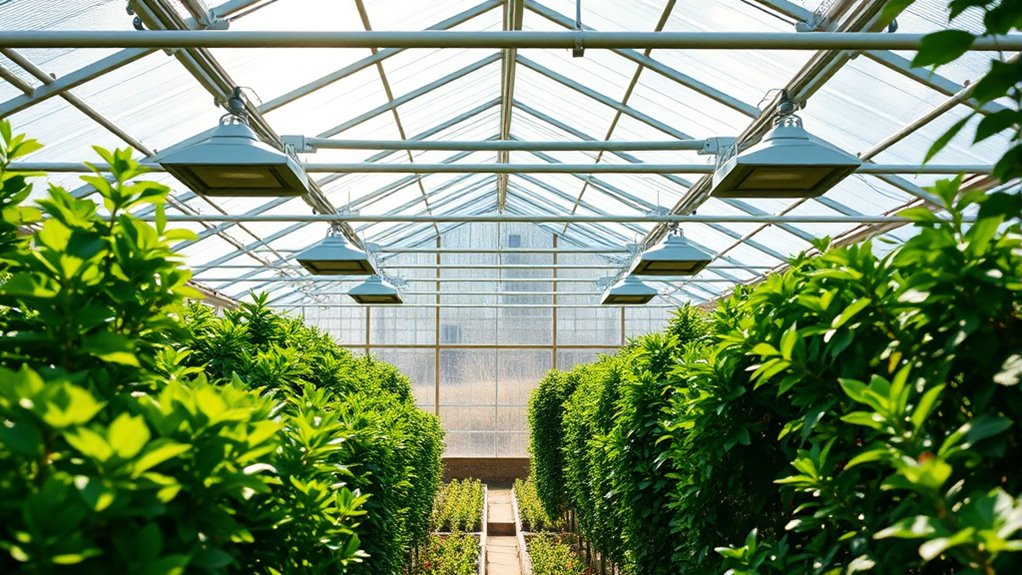
When setting up your greenhouse, ventilation systems play a vital role in maintaining a healthy environment for your plants.
You can choose between manual and automatic ventilation, each offering unique temperature control benefits.
Understanding how these systems impact temperature regulation will help you create the ideal conditions for thriving plants.
Manual vs. Automatic Ventilation
How do you decide between manual and automatic ventilation systems for your greenhouse?
Both options have their strengths, so consider the following:
1. Cost: Manual systems are typically less expensive to operate, but they require more maintenance.
Automatic systems, while pricier to run, offer consistent ventilation regardless of weather conditions.
2. Airflow Control: Manual systems rely on natural air movement, which can be inconsistent.
In contrast, automatic systems use fans for precise airflow management.
3. Customization: Manual systems can be tailored to meet specific plant needs, while automatic systems provide convenience with integrated controls.
Ultimately, your choice should align with your budget, climate, and the types of plants you’re growing.
Each system has unique benefits worth considering.
Temperature Control Benefits
Maintaining the right temperature in your greenhouse is essential for plant health, especially since ideal growth occurs within a range of 77-83°F.
A well-designed ventilation system prevents excessive heat, guaranteeing temperatures don’t exceed 84°F, which could harm your plants. It also helps manage humidity levels, reducing the risk of fungal diseases and condensation.
Efficient air circulation minimizes temperature differences, promoting uniform growth throughout your greenhouse. Additionally, proper ventilation guarantees a steady supply of carbon dioxide for photosynthesis, boosting plant growth.
By implementing effective ventilation, you can lower energy costs by reducing heating and cooling needs while creating a healthier environment for both your plants and yourself.
Don’t underestimate the importance of a good ventilation system!
Optimizing Space for Efficiency

Here are three key methods to optimize your garden area:
- Utilize Vertical Space: Install multi-level shelving, tiered plant stands, and hanging planters to expand your growing area without crowding the floor.
- Create Efficient Pathways: Use narrow aisles and stepping stones to enhance accessibility while ensuring plants have ample room to thrive.
- Incorporate Seasonal Planting: Implement succession planting and crop rotation to maximize every inch of space throughout the year. Additionally, consider incorporating pollinator-attracting varieties to enhance your greenhouse’s productivity and biodiversity.
Navigating Local Zoning Laws
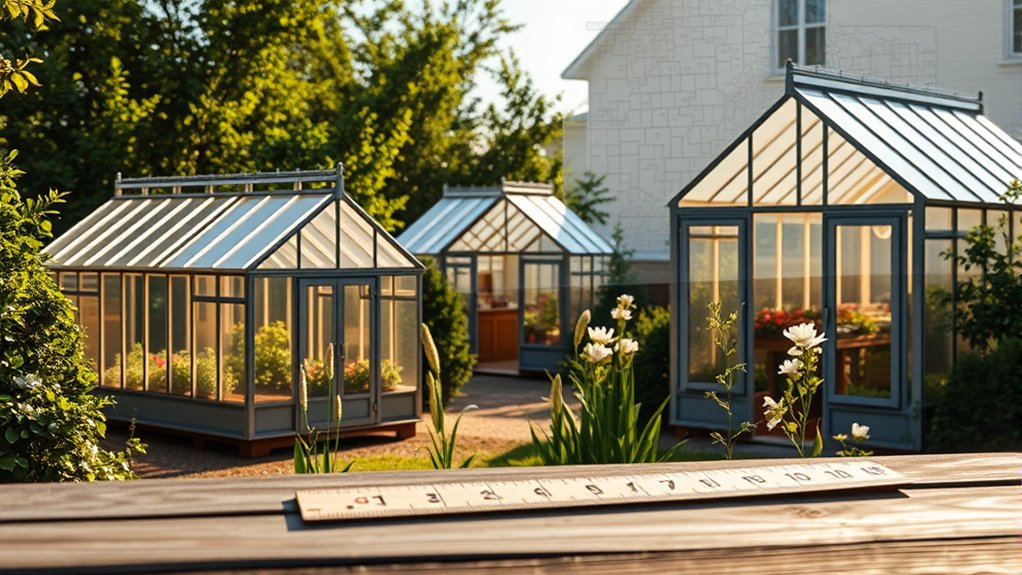
When planning your greenhouse, understanding local zoning laws is just as important as optimizing your space. Zoning regulations dictate your greenhouse’s size, height, and location, guaranteeing compatibility with the neighborhood. You’ll need to prepare detailed site plans and address community concerns during public hearings.
| Aspect | Importance | Action Required |
|---|---|---|
| Zoning Approval | Necessary for permits | Educate officials on greenhouses |
| Public Hearings | Address community concerns | Prepare to discuss impacts |
| Building Permits | Guarantee safety and compliance | Submit required documentation |
Navigating these laws can be challenging, but compliance helps avoid fines or legal issues, paving the way for a successful greenhouse project.
Frequently Asked Questions
What Climate Conditions Affect Greenhouse Size Selection?
Climate conditions greatly affect your greenhouse size selection.
If you live in a colder area, you’ll need a larger greenhouse for better insulation against frost. In contrast, warmer climates might require additional cooling systems, influencing size as well.
Areas with high rainfall might need steeper roofs to handle water.
Ultimately, understanding your local climate helps you determine the best greenhouse size to guarantee ideal plant growth and sustainability in your gardening efforts.
How Do I Determine My Greenhouse’s Orientation?
To determine your greenhouse’s orientation, start by evaluating sunlight exposure. Ideally, face it south to maximize sunlight, especially in colder climates.
An east-west orientation is great for winter growth, allowing low-angle sunlight in. Avoid north-facing setups, as they receive the least light.
Also, consider nearby structures that might cast shadows and the local wind patterns, as these can impact your greenhouse’s overall efficiency and plant health.
Can I Use a Greenhouse for Aquaponics or Hydroponics?
Yes, you can definitely use a greenhouse for aquaponics or hydroponics! The controlled environment helps maintain the ideal temperature and humidity for both systems.
You’ll find that maximizing vertical space increases your plant yield. Just make sure your greenhouse design accommodates your chosen system’s requirements, including water management and electrical needs.
With proper planning, you’ll create a thriving ecosystem that benefits both your plants and fish!
What Are the Best Greenhouse Accessories to Consider?
When you step into your greenhouse, it should feel like a plant paradise!
To make that dream a reality, consider must-have accessories. You’ve got heaters for warmth, watering cans for precision, and shading systems to pamper your delicate plants.
Don’t forget shelf kits to maximize space and automatic vent openers for perfect climate control.
With these tools, you’ll create an oasis where your plants will thrive like they’re on vacation!
How Do I Maintain Optimal Humidity Levels in a Greenhouse?
To maintain ideal humidity levels in your greenhouse, monitor the environment regularly with a hygrometer.
You can increase humidity by placing water trays or using misting systems. If humidity gets too high, guarantee good ventilation by opening doors or using fans.
Consider installing a dehumidifier for more control.
Conclusion
As you stand in your garden, envision a greenhouse perfectly nestled among your blooms, serving as a sanctuary for your plants. By considering your available space, goals, and budget, you can create a thriving environment where vibrant greens flourish under the sun. Picture the gentle breeze flowing through well-placed vents, nurturing your plants. With thoughtful planning and the right choices, your greenhouse will become a lush haven, transforming your gardening dreams into a colorful reality.
